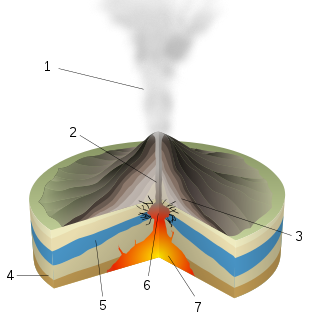Phreatic eruption
Volcanic eruption caused by an explosion of steam From Wikipedia, the free encyclopedia
A phreatic eruption, also called a phreatic explosion, ultravulcanian eruption or steam-blast eruption,[1] occurs when magma heats ground water or surface water. The extreme temperature of the magma (anywhere from 500 to 1,170 °C (930 to 2,100 °F)) causes near-instantaneous evaporation of water to steam, resulting in an explosion of steam, water, ash, rock, and volcanic bombs.[2] At Mount St. Helens in Washington state, hundreds of steam explosions preceded the 1980 Plinian eruption of the volcano.[2] A less intense geothermal event may result in a mud volcano.[citation needed]
Look up phreatic in Wiktionary, the free dictionary.


Phreatic eruptions typically include steam and rock fragments; the inclusion of liquid lava is unusual. The temperature of the fragments can range from cold to incandescent. If molten magma is included, volcanologists classify the event as a phreatomagmatic eruption. These eruptions occasionally create broad, low-relief craters called maars. Phreatic explosions can be accompanied by carbon dioxide or hydrogen sulfide gas-emissions. Carbon dioxide can asphyxiate at sufficient concentration; hydrogen sulfide acts as a broad-spectrum poison. A 1979 phreatic eruption on the island of Java killed 140 people, most of whom were overcome by poisonous gases.[3]
Examples of phreatic eruptions
- Cumbre Vieja - In the 2021 La Palma eruption, new eruptive vents tended to announce themselves with a phreatic explosion, followed soon after by the opening of a new fissure vent in the same location.[citation needed]
- Krakatoa – Indonesia, 1883 (see 1883 eruption of Krakatoa) – it is believed that the eruption, which obliterated most of the volcanic island and created the loudest sound in recorded history, was a phreatomagmatic event.[4][5]
- Ritter Island – Papua New Guinea, 1888 (see 1888 Ritter Island eruption and tsunami) – Resulted in the largest lateral spreading of a volcanic cone in human history.[6]
- Kilauea – Hawaii, United States – the volcano has a long record of phreatic explosions; a 1924 phreatic eruption hurled rocks estimated at eight tons up to a distance of one kilometer.[7]
- Surtsey – Iceland, 1963–65
- Taal Volcano – Philippines, 1965, 1977, 2020
- Mount Ontake – Japan, 2014 (see 2014 Mount Ontake eruption)
- Mayon Volcano – Philippines, 2013
- Whakaari/White Island – New Zealand, 2019 (see 2019 Whakaari/White Island eruption)
- Mount Bulusan – Philippines, 2022
See also
- Types of volcanic eruptions
- Phreatic – Term used in several scientific disciplines
- Hydrothermal explosion – Explosion of superheated ground water converting to steam
- Steam cannon – Projectile launcher powered by heat and water
References
Wikiwand - on
Seamless Wikipedia browsing. On steroids.
